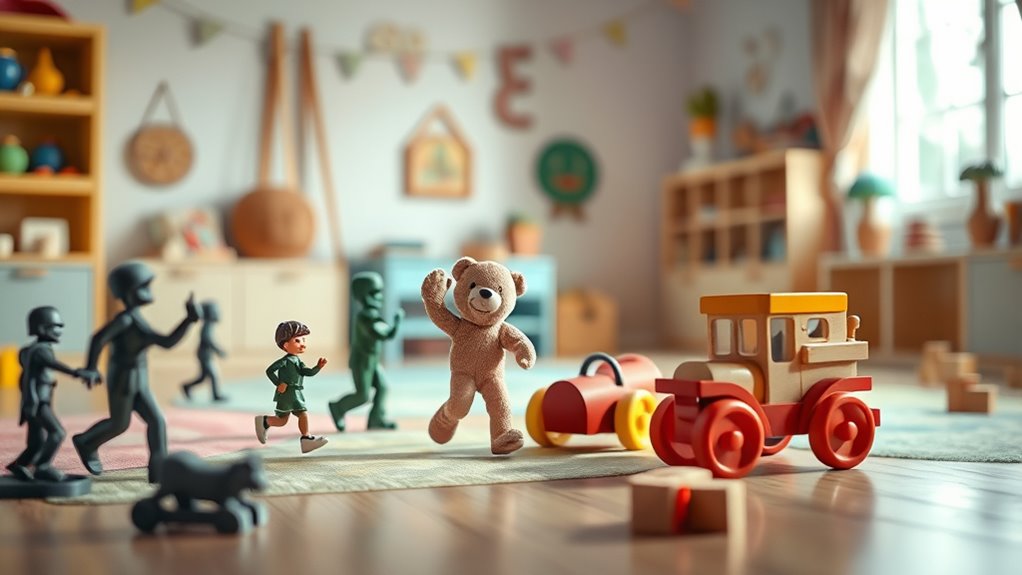When toys come alive with trigger objects and motion sensors, they respond instantly to your child’s movements or actions, making playtime exciting and interactive. These features let toys sing, dance, or react as kids explore, encouraging creativity and learning about cause and effect. Proper safety measures are essential to prevent false triggers or hazards. Keep going to discover how these innovative toys can boost play and development while staying safe and fun.
Key Takeaways
- Trigger objects and motion sensors activate toys when detecting movement or presence, enabling interactive responses.
- These features enhance play by making toys sing, dance, or react, encouraging active and imaginative engagement.
- Accurate sensors prevent false activations, ensuring safe and appropriate toy responses during playtime.
- Proper safety standards and secure electronic components are essential to prevent injuries and ensure toy durability.
- Regulatory compliance and supervision are vital for safe use, especially for young children interacting with electronic toys.

Imagine a toy that springs to life the moment you walk into the room or pick it up—thanks to trigger objects and motion sensors, that’s now possible. These advanced features transform simple toys into interactive companions, making playtime more engaging and dynamic. When you introduce trigger objects or motion sensors into a toy, you create opportunities for interactive play that capture kids’ imaginations. The toy reacts to your presence or actions, encouraging kids to explore, experiment, and develop their creativity. For example, a plush animal might start singing when you approach or a robot could begin dancing when it detects movement nearby. This level of responsiveness keeps children entertained and promotes active participation, rather than passive watching. Understanding how these technologies work can help caregivers select the most suitable toys for safe and effective play. However, integrating these technologies also raises important safety considerations. Because these toys respond to environmental stimuli, it’s essential to guarantee they are designed with safety in mind. For instance, motion sensors should be highly accurate to prevent false activations that might startle or frighten children. The trigger objects used should be free of small parts or sharp edges, reducing choking or injury risks. Additionally, these toys often require batteries or electronic components, so secure casing is critical to prevent access to wires or batteries that could be swallowed or mishandled. Proper electronic component safety standards should be verified when selecting toys to ensure long-term reliability and protection. Regular safety testing can help identify potential hazards early and maintain toy quality. Using high-quality sensor technology can enhance the accuracy and responsiveness of interactive toys, making playtime even more engaging. As a parent or caregiver, you should always check the manufacturer’s safety guidelines and choose toys that meet recognized safety standards, such as ASTM or CE certifications. Using trigger objects and motion sensors enhances the overall interactive play experience by making toys more responsive and personalized. Kids learn cause-and-effect relationships quickly when they see a toy react to their movements or actions. This not only makes playtime more fun but also boosts cognitive development, motor skills, and social interaction. Furthermore, understanding state-specific regulations related to electronic toys can help ensure compliance and safety. Nonetheless, it’s essential to supervise play with these high-tech toys, especially with younger children who might not understand their electronic nature. Keep an eye on the toy’s battery life and guarantee that the sensors function correctly to avoid unexpected malfunctions. Establishing boundaries around playtime and inspecting toys regularly will help maintain a safe environment.
Frequently Asked Questions
How Do Trigger Objects Differ From Traditional Toy Mechanisms?
Trigger objects differ from traditional toy mechanisms because they activate features through sensors rather than manual parts. When you use trigger objects, you rely on sensor calibration to guarantee accurate responses, making the toy more interactive. These toys must also meet toy safety standards to prevent accidents. Unlike simple mechanisms, trigger objects respond automatically to motion or contact, creating a more engaging experience while emphasizing safety and precise sensor functioning.
Can Motion Sensors Be Safely Used Around Pets?
They say “better safe than sorry,” and that’s true for using motion sensors around pets. You can securely use them if you prioritize pet safety by carefully choosing sensor placement, keeping sensors out of pets’ reach, and avoiding overly sensitive devices that could cause false alarms. Always monitor your pets’ reactions and test the sensors regularly to make sure they’re functioning correctly without causing stress or harm.
What Are the Best Materials for Durable Trigger Objects?
For durable trigger objects, you want materials with high material durability and environmental resistance. Choose plastics like ABS or polycarbonate, which withstand impact and wear. Rubber offers flexibility and resilience against weather conditions, making it ideal for outdoor use. Metal parts, such as stainless steel or aluminum, provide strength and longevity. These materials guarantee your trigger objects remain functional over time, resisting damage from moisture, temperature changes, and frequent use.
Do Motion Sensors Require Wi-Fi or Internet Connection?
Think of motion sensors as vigilant gatekeepers in your smart home. They don’t need Wi-Fi or internet to detect movement; they operate on wireless technology like infrared or ultrasonic signals. These sensors communicate locally with connected devices, so your automation runs smoothly without constant internet. However, for remote access or updates, an internet connection enhances functionality. So, your motion sensors stay alert, whether or not you’re online.
Are There Age Restrictions for Toys With Motion Sensors?
You might wonder about age restrictions for toys with motion sensors. Manufacturers usually set age guidelines based on safety considerations, especially for small parts or complex features. Always check safety guidelines before giving these toys to a child, as younger kids might accidentally activate sensors or misuse them. Following age restrictions helps guarantee safe play, reducing risks and making sure children enjoy their toys responsibly and securely.
Conclusion
As you explore how trigger objects and motion sensors breathe life into toys, remember they turn ordinary play into a magical dance. Like a well-choreographed performance, these technologies transform static objects into storytellers, sparking wonder and imagination. So next time a toy surprises you, realize it’s not just a gadget—it’s a gateway to a world where the impossible becomes possible, reminding you that sometimes, magic is just science waiting to be unveiled.









